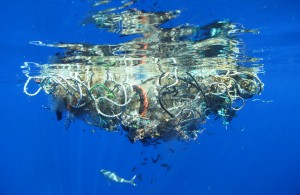Have you heard about a huge floating island of plastic? You may not believe it, but there it is in the central North Pacific Ocean, called the Great Garbage Patch. The size of the garbage patch is enormous estimated about twice the size of Texas! Charles Moore, the scientist who first discovered the garbage patch, mentioned that the garbage island will even likely double in size in the next ten years. The Great Garbage Patch has become a discourse of environmental debate for its adverse effects on marine life.
Though there are various types and sizes of debris, the majority of the marine debris consists of plastics. Algalita Marine Research Foundation, an organization that studies sampling the marine debris to determine the density of plastic debris in the pacific garbage patch, analyzed the increasing ratio of plastic to zoo plankton by weight. This means that the concentration of plastic debris is increasing, contaminating the largest biome on Earth. Increasing accumulation of plastic debris leads to the biological loss by entanglement and ingestion. Every year, over 100000 ocean animals become trapped in marine debris and unfortunately, many of them die. In addition, many marine organisms ingest plastic debris, mistaking them as their food source, being poisoned and starved.
The chemical toxicity in plastics is another factor that deteriorates marine ecosystem. Plastic debris not only contains organic contaminants, but it also contains persistent organic pollutants such as pesticides and petroleum hydrocarbons, which are resistant to environmental degradation: they will remain in the water, aggravating and propelling the speed of contamination of marine life. Also, the high concentration of contaminants causes lethal threats to marine ecosystem as they accumulate in their body through ingestion. Contaminants, such as phthalates and Bisphenol A (BPA), adversely affect reproduction in many marine animal groups, disrupting the development of amphibians and inducing genetic abnormality. BPA acts as a feminizing agent that produces an estrogenic effect in fish. It also affects the processes of sex hormones and disrupts growth, insulin signaling, bone development and brain development. Furthermore, bioaccumulation of chemicals can occur; persistent organic pollutant can accumulate in the fatty tissues of organisms and higher the trophic level, the greater potentially the negative effect on birth or mortality of marine animals.
From the serious damages caused by the garbage patch, people have to be aware that we have caused the destruction of marine life. The environment constantly lets us know through diseases or disasters that it needs care, and people must pick up on the cues and change their behavior in order to save the world from a dark future!
YouTube video courtesy of: National Geographic
By InHye(Lisa) Kim
I commented on :
Adrian Li’s post on “Vitamin C. Miracle Cure or Wannabe Dud or Neither?”
Grace Kim’s post on “Almost there! Universal blood for all.”
Julia He’s post on “My Grandma Can Become Stronger by Eating Apples and Tomatoes.”



